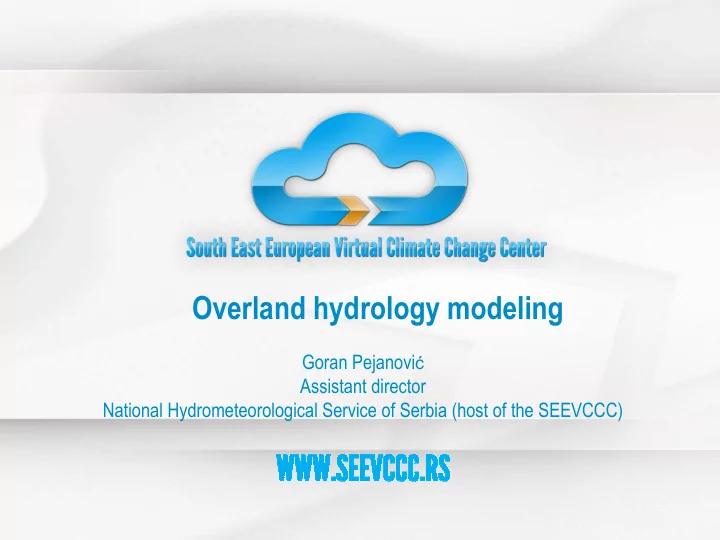

Overland hydrology modeling Goran Pejanovi ć Assistant director National Hydrometeorological Service of Serbia (host of the SEEVCCC)
Hydrologic cycle and its modeling • atmosphere model: cloud microphysics precipitation • land surface model: soil moisture evapotranspiration interception snowmelt infiltration surface runoff subsurface runoff • hydrology model: • available high-resolution datasets on: overland flow topography underground flow land use, land cover river discharge soil types, soil texture vegetation cover • ocean model
Hydrological models • statistical models correlation between precipitation amount and river discharge simple equations, lot of parameters that should be calibrated • conceptual models • physically based models differential equations based on physical lows, but often oversimplified (kinematical approximation), fewer parameters for calibration Hydrological model should: • dynamically treat overland and underground flow • be universal (easy to apply on any watershed, short and long term integrations) • be a callable routine within an atmospheric model • be computationally efficient
HYdrology PROgnostic Model • atmosphere: NCEP’s Numerical Mesoscale Model NMM-E non-hydrostatic model • land: NOAH land surface scheme • hydrology: HYPROM2d: surface runoff HYPROM1d: river routing • datasets: HYDRO1km USGS topography FAO soil texture data USGS landuse data
Governing equations: h – points u – points ∂ ∂ ∂ ∂ u u u h river points A-B-C-D-E-F + + + + − = u v g S S 0 fx 0 x ∂ ∂ ∂ ∂ t x y x ∂ ∂ ∂ ∂ v v v h + + + + − = u v g S S 0 fy 0 y ∂ ∂ ∂ ∂ t x y y F ( ) ( ) • ∂ ∂ ∂ h hu hv + + + = H 0 ∂ ∂ ∂ E t x y • Dynamical treatment of overland flow D C (NO kinematical approximation!) • Numerically stabile implicit time scheme for B the friction term • New numerical scheme for preventing grid A decoupling noise d • Reference: • Horizontal advection scheme is mass conserving and positive definite Nickovic et al., 2010, HYPROM Hydrology Surface-Runoff Prognostic model, Water Resources Research, 46, W11506
LSM as a vertical hydrology component precipitation evaporation Liquid water content forecast : Darcy’s Law interc. surface runoff ∂ ∂ ∂ W W l = l + γ + K R w w ex ∂ ∂ ∂ t z z snow melt W l diffusivity conductivity + 2 + b 2 b 3 W W γ = γ l = l K K W w ws w ws W W l s s K saturated diffusivity ws W l γ saturated conductivity ws W porosity (max. soil moisture content) s b Clapp-Horneberger constant baseflow
Case study: the Savinja river, flash flood event watershed: 1850 km 2 T and V at 850 hPa, 1Nov1990 acc. rainfall 26 Oct – 6 Nov1990 accumulated precipitation (mm) model .vs. observations river discharge (m^3/s) forecast hour (h) forecast hour (h)
Case study: the Moraca river watershed: 3200 km 2 heavy rain event: example of model’s dynamics surface runoff and streamlines 7 th Feb. 2003 5 th Feb. 2003
River discharge sensitivity to soil types Clay Loam parameter Bedrock (15) (09) 0.113 x 10 ‐ 4 0.136 x 10 ‐ 3 sat. diffusivity sat. 2.45 x 10 ‐ 6 1.41 x 10 ‐ 4 conductivity porosity 0.465 0.20 CH constant 8.17 2.79
Water budget components: six months accumulations November 2002 – April 2003 precipitation snow melt runoff evaporation
One year runs: river discharge year: 2003 BIAS: - 2.43 MAE: 35.48 RMSE: 55.48 model .vs. observations CC: 0.94 FEC: 0.87 year: 2008
Case study: the Skadar lake, climate simulations the Skadar lake watershed: 5180 km 2 RCM-SEEVCCC: resolution ~35km, A1B SRES/IPCC scenario NMM-E nesting: resolution ~8km modeled river discharge control year: 2003 on the Bojana river simulation: 2020 - 2030
HYPROM conclusions: ● Dynamical treatment of overland flow ● Suitable for long term and flash flood simulations ● Applicative to small and large watersheds ● Off-line and on-line mode ● No calibration needed ● Computationally efficient • Couple with NMM-B + LISS • Dynamical treatment of subsurface flow (if possible) HYPROM example for the Danube watershed
Recommend
More recommend